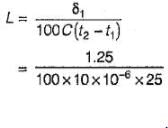Test: Pavement Design - 2 - Civil Engineering (CE) MCQ
20 Questions MCQ Test - Test: Pavement Design - 2
The width of expansion joint gap is 2.5 cm in a cement concrete pavement. The spacing between expansion joint for a maximum rise in temperature of 25°C is (assuming coefficient of thermal expansion of concrete as 10 x 10-6 per °C)
In the plate bearing test, if the load applied is in the form of an inflated type of wheel, then this mechanism corresponds to
The standard plate size in a plate bearing test for finding modulus of sub-grade reaction (k) value is
Consider the following statements:
1. In a concrete pavement temperature stress is tensile at bottom during day time.
2. In a concrete pavement load stress is compressive at bottom.
Which of these statements is/are correct?
It is customary to design the thickness of cement concrete pavement for
In reinforced cement concrete pavements, steel is placed
The sub-grade soil properties of a sam ple are as follows:
Soil portion passing 0.075 mm sieve = 50%
Liquid limit = 40%
Plasticity index = 20%
The group index of the soil is
Consider the following factors :
1. Magnitude of load
2. Thickness of cement concrete slab
3. Temperature distribution in the slab
4. Modulus of sub-grade reaction
Which of these should be taken into reckoning to determine the wheel load stress at critical location in a cement concrete pavement?
If the pressure carried by a CBR specim en at 2.5 mm penetration is 3.5 N/mm2, the CBR of the soil is
Consider the following statements: The failure of sub-grade of a flexible pavement is mainly attributed to
1. inadequate stability
2. loss of binding action
3. loss of base course materials
4. excessive stress concentration
Which of the statements are correct?
Consider the following statements: In the design of modern concrete pavements, tie bars are used:
1. As load transfer devices
2. In expansion joints
3. In contraction joints
4. In warping joints
Which of the statements given above is/are correct?
If the CBR value obtained at 5 mm penetration is higher than that at 2.5 mm, then the test is repeated for checking: and if the check test reveals a. similar trend, then the CBR value is to be reported as the
If the load, warping and frictional stresses in a cement concrete slab are 210 N/mm2, 290 N/mm2 and 10 N/mm2 respectively, the critical combination of stresses during summer midday is
In the design of highway expansion and contraction joints should respectively be provided at
In the CBR design method recommended by the IRC for the design of flexible pavement, the total thickness depends upon
If the radius of wheel load distribution is 30 cm and slab thickness is 15 cm, then the equivalent radius of resisting section is
The critical combination of stresses for corner region in cement concrete roads is























